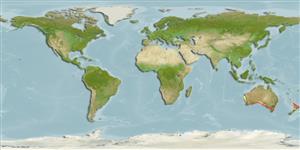Environment: milieu / climate zone / depth range / distribution range
Écologie
marin démersal; profondeur 10 - 300 m (Ref. 33616). Temperate; 25°S - 43°S
Eastern Indian Ocean: southern Australia, from Western Australia to New South Wales, including Tasmania.
Taille / Poids / Âge
Maturity: Lm ? range ? - ? cm
Max length : 22.0 cm SL mâle / non sexé; (Ref. 33616)
Description synthétique
Clés d'identification | Morphologie | Morphométrie
Épines dorsales (Total) : 9; Rayons mous dorsaux (Total) : 15 - 16; Épines anales: 0; Rayons mous anaux: 16 - 17; Vertèbres: 31.
Occur on coastal waters, in the continental shelf area (Ref. 33616).
Life cycle and mating behavior
Maturité | Reproduction | Frai | Œufs | Fécondité | Larves
Neira, F.J., A.G. Miskiewicz and T. Trnski, 1998. Larvae of temperate Australian fishes: laboratory guide for larval fish identification. University of Western Australia Press. 474 p. (Ref. 33616)
Statut dans la liste rouge de l'IUCN (Ref. 130435: Version 2024-1)
Menace pour l'homme
Harmless
Utilisations par l'homme
Pêcheries: sans intérêt
Outils
Articles particuliers
Télécharger en XML
Sources Internet
Estimates based on models
Preferred temperature (Ref.
123201): 14 - 19.8, mean 16 °C (based on 139 cells).
Phylogenetic diversity index (Ref.
82804): PD
50 = 0.5000 [Uniqueness, from 0.5 = low to 2.0 = high].
Bayesian length-weight: a=0.00676 (0.00325 - 0.01404), b=3.05 (2.87 - 3.23), in cm total length, based on LWR estimates for this (Sub)family-body shape (Ref.
93245).
Niveau trophique (Ref.
69278): 3.5 ±0.3 se; based on size and trophs of closest relatives
Résilience (Ref.
120179): Milieu, temps minimum de doublement de population : 1,4 à 4,4 années (Preliminary K or Fecundity.).
Fishing Vulnerability (Ref.
59153): Low vulnerability (17 of 100).
